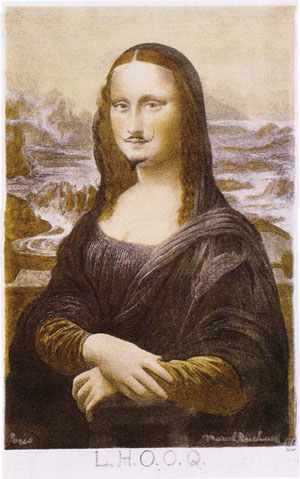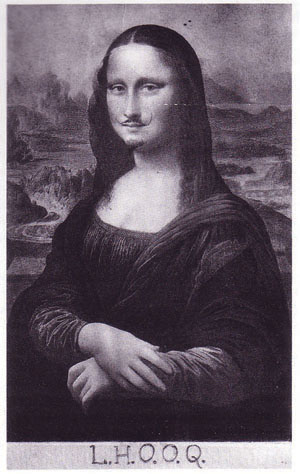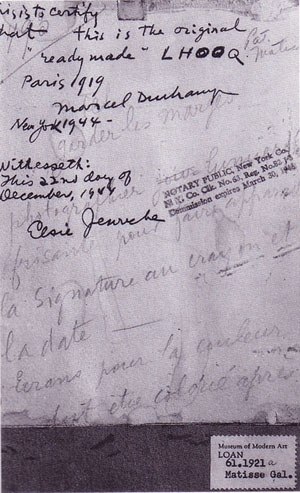
L.H.O.O.Q.
or
Mona Lisa
 |
| Replica, 1940? |
|
Original Version:
1919, Paris |
It appears not to be a stretch to say that this is "Duchamp's most famous ready-made" (Ramirez 46). Many people, including those outside of academia, recognize this now infamous image as inextricably attached to Marcel Duchamp.
This cheap reproduction of the famous ideal of beauty that is Leonardo da Vinci's Mona Lisa has been adorned with a comical moustache and goatee, thus deserving its alternate title Joconde aux Moustaches. L.H.O.O.Q. is two-dimensional, like only several other Readymades including Apolinere Enameled, Pharmacy, and French Military Paper.
The title is essentially a phonetic game. As Duchamp himself noted in a 1966 interview, "I really like this kind of game, because I find that you can do a lot of them. By simply reading the letters in French, even in any language, some astonishing things happen" (Cabanne 63). When read quickly in French, the title L.H.O.O.Q. sounds like a sentence translating to "She has a hot bum/ass." This is the most commonly sited meaning of the phrase, but many other ideas also surround this intriguing group of letters. Duchamp gave a "loose" translation of L.H.O.O.Q. as "there is fire down below" in a late interview (Schwarz 203). Steefel points out that, when spoken in English, L.H.O.O.Q. sounds like "LOOK" (50). Thus the piece could have a further function as a commentary on the relationship between artist and viewer, which Duchamp was admittedly very interested in. Kuspit supports a much more overtly sexual interpretation, explaining, "It is a multilayered pun: the letters become words which become a devaluing male comment on the beautiful, dignified woman - she's just another slut. She's smiling because she's thinking of being fucked - more probably, of masturbating, that is, fucking herself" ("Laugh" 111).
 |
| Original version, 1919 (front) |
The viewer should be wary of reading too far into something that is really only grounded in speculation. Could the artist have not intended such a reading? We may never know for sure, but Philip Larson argues an interesting point (although without citing a source for this fact, his assertion seems just as ungrounded as the speculations he argues against): "Not found in most writings about Duchamp is the faintly amusing fact that Duchamp intended us to read the inscription as a series of enunciated French letters, like O.U.R.A.Q.T. in English. The Duchamp blurb comes out as something more unforgivable than 'She has a hot ass'" (213).
Finally, Duchamp's choice of the Mona Lisa may not have been as arbitrary as often assumed. There may be a more personal reason why Duchamp focused on this particular example of ideal aesthetic beauty. Duchamp's friend Guillaume Apollinaire was falsely detained in connection with the theft of the Mona Lisa and some small sculptures from the Louvre several years prior to Duchamp's creation of this Readymade. This may be Duchamp's way of indirectly referencing his friend Apollinaire.
 |
| Original version, 1919 (back) |
Replicas:
1) 1920, Paris
Present location unknown
2) 1930, Paris
Private Collection, Paris
Large scale replica
3) 1940, Paris
Color reproduction, made by Duchamp from original version
Stolen in 1981 and never recovered
4) 1958, Cadaques
Collection Antoni Tapies, Barcelona
5) 1960, Huismes (Indre et Loire)
Collection Dorothea Tanning, New York
Oil on wood
6) Sept. 1964, Neuilly
Collection Arturo Schwarz, Milan
38 replicas to be inserted in limited edition volume of Pierre de Massot's Marcel Duchamp, propos et souvenirs